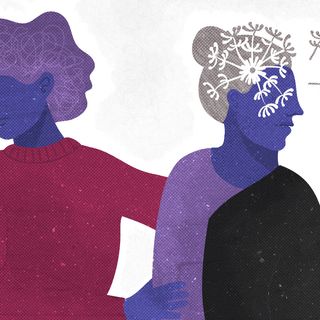
How Weightlifting Helped Me Heal After Domestic Violence
“For the first time, I trusted my body.”

I have always had a tenuous relationship with my body. Its triangular shape — small face, narrow shoulders, wide hips, exactly like a triangle that escaped a geometry lesson – often filled me with disgust. All of my teenage years and most of my 20s were spent in devising newer, cleverer ways of hiding the misshapen thing and struggling to rewrite its shape to align to whom I thought I was. Diets, exercises, mini-breakdowns in dressing rooms, constant checking in the mirror, the eyes trying to unsee what it was seeing … it took up so many of my waking hours, this continuous, deep engagement with what my body wasn’t. It was almost as if the only way out of this quicksand of imagined desire, of what my body should be, was to drown and hopefully resurface on the other side with a new body.
Then two things happened.
In my 29th year, I gave birth to my first child and my first epiphany: my body had this incredible capacity to not give up despite the emotional hell I had put it through. I found myself celebrating that body, that thing to be hidden, like a maestro grudgingly accepting new talent.
In my 30th year, that epiphany changed its color: my body had an incredible capacity to not give up, yes, but I realized I could cease to exist. This was the year I began to face domestic abuse.
Related on The Swaddle:
Know Your Rights: Navigating Domestic Violence Laws in India
Domestic abuse, much like bodies, comes in many shapes and sizes. And, yet, unlike bodies, domestic abuse in its many shapes and sizes is largely accepted by society (not the law) because ‘it’s okay between a husband and a wife.’ According to the most recent National Family Health Survey, every third woman has faced some kind of domestic violence in the country. In Chennai, the city I live in, the all-woman Police Stations released a joint report in 2005, which stated that ‘there were 10,508 cases of physical, sexual, verbal and mental abuse reported to them by women over the course of three years. By 2012, I was one of those women.
In any kind of physical attack, you become painfully aware of the different parts that make up the sum of your body — face, jaw, shoulders, arm, hip, bone, muscles, and skin. But in my case, I also became painfully aware of my lack of strength to fight abuse. I don’t just mean physical strength, because anyone who has faced abuse knows that hitting back physically means bracing for the next onslaught; I mean a lack of strength to face the debilitating breakdown of trust, the volatile power of love, and the deep roots of conditioning. How could I be a victim when I could still hold my own, when I had money in the bank, when I had a family who would support me, when I had a career as a writer, when I had friends, and when I still hoped the man I married after seven years of dating would break out of this pattern, that it was up to me to help, up to me to watch my words, up to me to watch my anger, up to me to hold my arguments, lest I provoke the other to lash out? This was a dangerous vortex, a cage that somehow did not feel out of place because of where it was placed — inside the house.
“It was ironic that at my most vulnerable everyone called me strong.”
Quite naturally, I went completely inward, my body back into hiding with bruises and marks, this time with an extra ingredient added to the old recipe of embarrassment and shame — a garnish of fear. And gradually, after my second pregnancy, I completely gave up, as did my body. The brief respect that birth brings to the body was non-existent this time, and I drowned myself in thick silence, like a dark sky just before a storm. I learned to be compassionate to my mind with therapy — but my body disappeared.
Then two things happened.
In my 34th year, I walked out of my marriage; it was ironic that at my most vulnerable everyone called me strong.
That same year, I found strength training and saw that it was true: this body of mine — me — is strong, and we are not, surprise surprise, two different entities.
On paper, strength training is a form of exercise that uses weights — barbells, dumbbells, kettlebells — to strengthen your body by building more muscle and increasing bone mass. It uses movement and mobility to do this effectively and some cardio to break the monotony. It is three sets of groans and aches, with six reps of pain and soreness each, followed by three sets of complaints and negotiations, with five reps of can-I-throw-the-coach-out-the-window, mixed with and-yet-I-am-coming-back-tomorrow-for-more. Health-wise and for purposes of fitness, strength training does wonders for the body; research papers and articles by experts and trainers abound on these benefits. But psychologically, strength training does something else; it trims and hems the edges of your mind to better hold the many frayed threads that make you, you. It makes you see and believe that emotional strength is never the same as physical strength — and yet, inextricably, they are connected.
Three months into strength training, I was riding my bike on the way to a session when I felt a sudden, volcanic rise of tears. It came out of nowhere, and I almost turned back, my throat choked, my lungs bursting, and my heart trying to contain it all. My limbs, however, prevailed, and one round of semicircular planks later, the volcano stopped its disquieting rumbling, like it had accepted its place in the queue. It doesn’t, however, mean the volcano never erupted — it did, oh so many times — but it also learned to wait, because I suddenly found the strength to open up enough space for the claustrophobia of waiting to disappear — from the years of invalidation, of not seeing my body, and the months of bristling justification — of seeing my body as broken parts.
Related on The Swaddle:
The Rage, and Fear, and Failure of Single‑Parenting
When I discovered this surge of strength coursing through my body, everything else fell by the wayside. My body, which had once upon a time made me feel ashamed, embarrassed, vulnerable and fearful, was now a mountain with a steadiness that was alien to me. To know that my feet were strong and sure as they hugged the Earth; that my back was strong and straight as it met the wind; that unknown niches were opening up in my muscles like delightful secrets tumbling out at long family dinners; and that at the best and especially the worst of times, my body would have the strength to hold me all of me together — it took me beyond the threshold of physicality and into the realm of the ethereal. For the first time, I trusted my body.
And just like that, I was walking and smiling confidently.
No, that’s not true. I was kicking and screaming my way through it, but, eventually, the confidence arrived. Eventually, like friendships that develop over time (or motherhood), I fell in love. I fell in love with the iron that doesn’t judge, that naturally listens, that remains gender-neutral (and a true feminist), and that welcomes you with the same enthusiasm, whether you meet it the next day, a week later, or even a year later. I fell in love with me, not as a triangular-shaped being, or one navigating her way out of a toxic marriage, but as someone with capable hands reaching out to grip the bar, as someone who could deadlift her body weight — literally and metaphorically carry her body — with an ease that came from the perpetual struggle of understanding.
I had found my body.
A couple of months ago, I had another epiphany at the gym. A triangular-shaped one, if I may. I realized that the bicep was called that because the muscle has two parts; the tricep, because it has three, and the quadricep, because it has four. Again, it sounds obvious, I know, but to me, discovering this simple nugget of biology quietly embedded in its etymology was like the skies had opened up to usher the shining sun — my body — glorious in all that it hides, and resplendent in all that it reveals.
Related:
Praveena Shivram is a writer based in Chennai, India, and currently the editor of Arts Illustrated, a pan-India arts and design-based magazine. Over the past 15 years, she has written for several national publications including The Times of India, India Today, The Hindu, Asiaville, Culturama and Biblio: A Review of Books. Her fiction has appeared in the Open Road Review, Jaggery Lit, Himal Southasian, Desi Writers' Lounge, Spark, Chaicopy and Helter Skelter’s anthology of New Writing Volume 6. More of her work can be found at praveenashivram.com.
Related


What It’s Like To Live With: A Mother With Alzheimer’s
